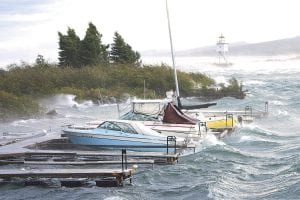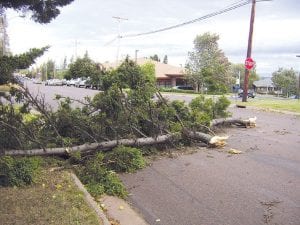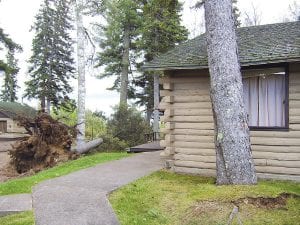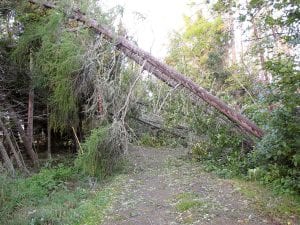Monday, September 28 came in like a lion and went out like a lion. Whitecaps whipped across the Grand Marais harbor, with waves crashing over the breakwall from the harbor side. Lake Superior was slate gray, and giant clouds rolled over the Sawtooth Mountains from the northwest.
At the Cook County airport, manager Rodney Roy reported wind speeds of 27 to 42 knots – roughly 31 to 48 miles per hour. “It’s blasting here,” he said. He wasn’t worried about the planes sitting outside, though, because they are always tied down whether it’s windy or not.
The primary problems in the county were downed trees blocking roads and power outages. Crews from Grand Marais Public Utilities and Arrowhead Electric Cooperative Inc. (AECI) worked through the day and night.
AECI Manager Don Stead said of the countywide outages being reported, “The linemen are doing their best, as they always do.”
However, recognizing the extent of the storm damage, the cooperative called for assistance from other cooperatives— Lake Country Power and East Central Electric—and from a contractor, Lake States. At press time on Wednesday, September 30, AECI spokesman Joe Buttweiler said there were still 200 members without power. All the main feeder power lines had been repaired, but numerous smaller distribution lines to single services still don’t have electricity. “Work is progressing slowly due to a number of broken poles that need replacement,” said Buttweiler.

Staff Photos/Jane Howard Above: The winds were so strong on Monday, September 28 that they tore down a light pole on Highway 61 in Grand Marais. Traffic backed up as the pole was pushed off the road. Upper right: Mountain ash and pines in Grand Marais were victims to the wind. Right: Nelson’s Traveler’s Rest suffered the loss of eight large trees and a picnic table.
Grand Marais Public Utilities also called for assistance to the Minnesota Municipal Utilities Association. Line crews came from Elk River, MN to assist. At press time, PUC Secretary Jan Smith said about half of the power on the east end of the city was still off. Another transformer had just blown. She said, “It seems like we take one step forward–and two steps bak. But they are working as hard as they can to get everyone back in service.”
Cook County Highway Department and Minnesota Department of Transportation (Mn/DOT) crews were also working long hours, clearing roads from one end of the county to another. One Hovland resident reported that between the trees and the downed power line near Ida Lane, “it looked like a war zone.”
Local fire departments were kept busy with calls of fires as trees fell on power lines. There were calls to put out fires on lines in Lutsen, Grand Marais, and Hovland. Fortunately the fires flamed and burned out quickly, in most cases before the fire departments even arrived.
U.S. Forest Service District Ranger Dennis Neitzke had crews out clearing trees before the stormy blast was over. He wasn’t worried about another blowdown like the one in 1999, however. Several times a year, he said, his crews are sent out to deal with the effects of wind, heavy snow, or ice.
Likewise, the North Superior Ski & Run Club conducts an annual cleanup at the Pincushion Mountain Trails. This year will be more difficult than previous years and NSSRC representative Dick Swanson invited any certified chainsaw operators and folks willing to “haul stuff off the trail” to come pitch in at the cleanup on Saturday, October 10 from 9:00 a.m. to 1:00 p.m.
Several boat owners docked at the Grand Marais Yacht Club next to the U.S. Coast Guard Station, suffered damage to their boats as the massive waves slammed across the harbor. One boat, belonging to Grand Marais Mayor Sue Hakes and her partner, John Gorski, sank in its slip and others belonging to Craig Schulte, Bruce Johnson, and Dave Tersteeg were slammed against the dock by the power of the waves. Also sinking was a Minnesota Department of Natural Resources conservation boat, which was docked at the Grand Marais Coast Guard Station. At press time, both boats had been recovered, but how much damage they sustained was yet to be determined.
Homeowners all over the county lost trees, but no significant damage to homes has been reported, although Tom and Patty Nelson of Nelson’s Traveler’s Rest in Grand Marais were hit hard. By mid-afternoon, eight large trees were down, blocking cabins, crushing a picnic table, overturning a Dumpster, and bearing down on a cabin roof. Later, a huge white pine went over. Patty said that ever since they bought the business in 1990, she had been saying, “It will be a sad day when that tree comes down.”
With all 12 of their cabins full, Nelsons had to send their guests to other places. Nelson worried throughout the day about some guests, one of whom was very ill, who had headed to the woods earlier. She has developed personal relationships with many of her guests. “They’re our very good friends,” she said. “Many of them have been coming here for 50-60 years.”
Looking on the bright side, Nelson’s Traveler’s Rest now has better views of the lake.

Staff Photos/Rhonda Silence Left: The wind blew all kinds of things around the county—including porta-potties at Coast Guard Point. Right: Sheriff Deputies and First Responders were called to rescue a person reportedly in distress on The Point. After confirming that the person was safe, Deputy Joe Zallar fought the wind back to safety.








Loading Comments